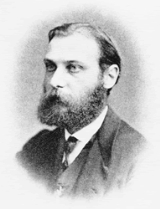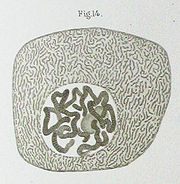
Walther Flemming
Encyclopedia
Walther Flemming was a German
Germany
Germany , officially the Federal Republic of Germany , is a federal parliamentary republic in Europe. The country consists of 16 states while the capital and largest city is Berlin. Germany covers an area of 357,021 km2 and has a largely temperate seasonal climate...
biologist
Biologist
A biologist is a scientist devoted to and producing results in biology through the study of life. Typically biologists study organisms and their relationship to their environment. Biologists involved in basic research attempt to discover underlying mechanisms that govern how organisms work...
and a founder of cytogenetics
Cytogenetics
Cytogenetics is a branch of genetics that is concerned with the study of the structure and function of the cell, especially the chromosomes. It includes routine analysis of G-Banded chromosomes, other cytogenetic banding techniques, as well as molecular cytogenetics such as fluorescent in situ...
.
He was born in Sachsenberg near Schwerin
Schwerin
Schwerin is the capital and second-largest city of the northern German state of Mecklenburg-Vorpommern. The population, as of end of 2009, was 95,041.-History:...
as the fifth child and only son of the psychiatrist
Psychiatrist
A psychiatrist is a physician who specializes in the diagnosis and treatment of mental disorders. All psychiatrists are trained in diagnostic evaluation and in psychotherapy...
Carl Friedrich Flemming
Carl Friedrich Flemming
Carl Friedrich Flemming was a German psychiatrist born in Jüterbog. He was the father of cellular biologist Walther Flemming ....
(1799–1880) and his second wife, Auguste Winter. He did his basic studies at the Gymnasium der Residenzstadt, where one of his colleagues and lifelong friends was writer Heinrich Seidel
Heinrich Seidel
Heinrich Friedrich Wilhelm Seidel was a German engineer, poet and writer.-Life:...
.
Career
Flemming trained in medicineMedicine
Medicine is the science and art of healing. It encompasses a variety of health care practices evolved to maintain and restore health by the prevention and treatment of illness....
at the University of Rostock
University of Rostock
The University of Rostock is the university of the city Rostock, in the German state of Mecklenburg-Vorpommern.Founded in 1419, it is the oldest and largest university in continental northern Europe and the Baltic Sea area...
, graduating in 1868. Afterwards. He served in 1879–1889 as a military physician in the Franco-Prussian War
Franco-Prussian War
The Franco-Prussian War or Franco-German War, often referred to in France as the 1870 War was a conflict between the Second French Empire and the Kingdom of Prussia. Prussia was aided by the North German Confederation, of which it was a member, and the South German states of Baden, Württemberg and...
. From 1873 to 1876 he worked as a teacher at the University of Prague
Charles University in Prague
Charles University in Prague is the oldest and largest university in the Czech Republic. Founded in 1348, it was the first university in Central Europe and is also considered the earliest German university...
. In 1876 he accepted a post as a professor of anatomy
Anatomy
Anatomy is a branch of biology and medicine that is the consideration of the structure of living things. It is a general term that includes human anatomy, animal anatomy , and plant anatomy...
at the University of Kiel
University of Kiel
The University of Kiel is a university in the city of Kiel, Germany. It was founded in 1665 as the Academia Holsatorum Chiloniensis by Christian Albert, Duke of Holstein-Gottorp and has approximately 23,000 students today...
. He became the director of the Anatomical Institute and stayed there until his death.
Making use of aniline
Aniline
Aniline, phenylamine or aminobenzene is an organic compound with the formula C6H5NH2. Consisting of a phenyl group attached to an amino group, aniline is the prototypical aromatic amine. Being a precursor to many industrial chemicals, its main use is in the manufacture of precursors to polyurethane...
dye
Dye
A dye is a colored substance that has an affinity to the substrate to which it is being applied. The dye is generally applied in an aqueous solution, and requires a mordant to improve the fastness of the dye on the fiber....
s he was able to find a structure which strongly absorbed basophilic
Basophilic
Basophilic is a technical term used by histologists. It describes the microscopic appearance of cells and tissues, as seen down the microscope, after a histological section has been stained with a basic dye. The most common such dye is haematoxylin....
dyes, which he named chromatin
Chromatin
Chromatin is the combination of DNA and proteins that make up the contents of the nucleus of a cell. The primary functions of chromatin are; to package DNA into a smaller volume to fit in the cell, to strengthen the DNA to allow mitosis and meiosis and prevent DNA damage, and to control gene...
. He identified that chromatin was correlated to threadlike structures in the cell nucleus
Cell nucleus
In cell biology, the nucleus is a membrane-enclosed organelle found in eukaryotic cells. It contains most of the cell's genetic material, organized as multiple long linear DNA molecules in complex with a large variety of proteins, such as histones, to form chromosomes. The genes within these...
— the chromosomes (meaning coloured body), which were thus named later on by German anamist Wilhelm von Waldeyer-Hartz (1841–1923). The Belgian scientist Edouard Van Beneden
Edouard Van Beneden
Edouard Joseph Marie Van Beneden , son of Pierre-Joseph Van Beneden, was a Belgian embryologist, cytologist and marine biologist. He was professor of zoology at the University of Liège. He contributed to cytogenetics by his works on the roundworm Ascaris...
(1846–1910) had also observed them, independently.
Flemming investigated the process of cell division
Cell division
Cell division is the process by which a parent cell divides into two or more daughter cells . Cell division is usually a small segment of a larger cell cycle. This type of cell division in eukaryotes is known as mitosis, and leaves the daughter cell capable of dividing again. The corresponding sort...
and the distribution of chromosomes to the daughter nuclei, a process he called mitosis
Mitosis
Mitosis is the process by which a eukaryotic cell separates the chromosomes in its cell nucleus into two identical sets, in two separate nuclei. It is generally followed immediately by cytokinesis, which divides the nuclei, cytoplasm, organelles and cell membrane into two cells containing roughly...
from the Greek word for thread. However, he did not see the splitting into identical halves, the daughter chromatids. He studied mitosis both in vivo
In vivo
In vivo is experimentation using a whole, living organism as opposed to a partial or dead organism, or an in vitro controlled environment. Animal testing and clinical trials are two forms of in vivo research...
and in stained preparations, using as the source of biological material the fin
Fin
A fin is a surface used for stability and/or to produce lift and thrust or to steer while traveling in water, air, or other fluid media, . The first use of the word was for the limbs of fish, but has been extended to include other animal limbs and man-made devices...
s and gill
Gill
A gill is a respiratory organ found in many aquatic organisms that extracts dissolved oxygen from water, afterward excreting carbon dioxide. The gills of some species such as hermit crabs have adapted to allow respiration on land provided they are kept moist...
s of salamander
Salamander
Salamander is a common name of approximately 500 species of amphibians. They are typically characterized by a superficially lizard-like appearance, with their slender bodies, short noses, and long tails. All known fossils and extinct species fall under the order Caudata, while sometimes the extant...
s. These results were published first in 1878 and in 1882 in the seminal book Zellsubstanz, Kern und Zelltheilung (1882; Cell substance, nucleus and cell division). On the basis of his discoveries, Flemming surmised for the first time that all cell nuclei came from another predecessor nucleus (he coined the phrase omnis nucleus e nucleo, after Virchow's
Rudolf Virchow
Rudolph Carl Virchow was a German doctor, anthropologist, pathologist, prehistorian, biologist and politician, known for his advancement of public health...
omnis cellula e cellula).

Gregor Mendel
Gregor Johann Mendel was an Austrian scientist and Augustinian friar who gained posthumous fame as the founder of the new science of genetics. Mendel demonstrated that the inheritance of certain traits in pea plants follows particular patterns, now referred to as the laws of Mendelian inheritance...
's (1822–1884) work on heredity
Heredity
Heredity is the passing of traits to offspring . This is the process by which an offspring cell or organism acquires or becomes predisposed to the characteristics of its parent cell or organism. Through heredity, variations exhibited by individuals can accumulate and cause some species to evolve...
, so he did not make the connection between his observations and genetic inheritance. Two decades would pass before the significance of Flemming's work was truly realized with the rediscovery of Mendel's rules. His discovery of mitosis and chromosomes is considered one of the 100 most important scientific discoveries of all times, and one of the 10 most important discoveries in cell biology
Cell biology
Cell biology is a scientific discipline that studies cells – their physiological properties, their structure, the organelles they contain, interactions with their environment, their life cycle, division and death. This is done both on a microscopic and molecular level...
(together with August Weismann
August Weismann
Friedrich Leopold August Weismann was a German evolutionary biologist. Ernst Mayr ranked him the second most notable evolutionary theorist of the 19th century, after Charles Darwin...
's (1834–1914) discovery of meiosis
Meiosis
Meiosis is a special type of cell division necessary for sexual reproduction. The cells produced by meiosis are gametes or spores. The animals' gametes are called sperm and egg cells....
, Theodor Schwann
Theodor Schwann
Theodor Schwann was a German physiologist. His many contributions to biology include the development of cell theory, the discovery of Schwann cells in the peripheral nervous system, the discovery and study of pepsin, the discovery of the organic nature of yeast, and the invention of the term...
(1808–1890) and Matthias Schleiden's (1804–1881) cell theory
Cell theory
Cell theory refers to the idea that cells are the basic unit of structure in every living thing. Development of this theory during the mid 17th century was made possible by advances in microscopy. This theory is one of the foundations of biology...
and Alfred Sturtevant
Alfred Sturtevant
Alfred Henry Sturtevant was an American geneticist. Sturtevant constructed the first genetic map of a chromosome in 1913. Throughout his career he worked on the organism Drosophila melanogaster with Thomas Hunt Morgan...
's (1866–1945) first genetic maps).
Flemming's name is honoured by a medal awarded by the German Society for Cell Biology (Deutschen Gesellschaft für Zellbiologie).
Further reading
and Reprinted in J. Cell Biol. 25:581-589 (1965).- Flemming, W. Zur Kenntniss der Zelle und ihrer Theilungs-Erscheinungen. In: Schriften des Naturwissenschaftlichen Vereins für Schleswig-Holstein 3 (1878), 23-27. (Reprinted in )
- Carlson, E.A. The Analysis of Mitosis Shifts Attention to the Chromosomes. In: Mendel's Legacy. The Origins of Classical Genetics. p. 24-5, CSHL Press, 2004. ISBN 0-87969-675-3.
External links
- Walther Flemming Biography. Lasker Labs
- Zellsubstanz, Kern und Zelltheilung. Original text of the book, as PDF (In German).
- Walter Flemming Medaille. In PDF, in German.
- Hardy, P. A., Zacharias, H. (2008): Walther Flemming und die Mitose: Der Beitrag seiner ersten Kieler Jahre. Schr. Naturwiss. Ver. Schlesw.-Holst. 70, 3-15. Paper about his first description of mitosis. In German.

